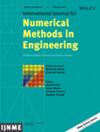The Novel High-Order Updated-Lagrangian Nonlocal General Particle Dynamics for Transient Anisotropic Seepage Problems in Unsaturated Porous Media
Abstract
In this paper, the novel high-order updated Lagrangian nonlocal general particle dynamics (UL-NGPD) is first proposed to solve anisotropic transient seepage flow problems, in which the novel high-order spatially nonlocal operators are first established to obtain accurate second-order nonlocal differential derivatives. The novel high-order UL-NGPD formulation and its corresponding numerical implementations of boundary conditions and time integration for seepage problems are established, which are capable of automatically capturing seepage surfaces without extra treatments and consider the complete time-dependent transition from unsaturated to saturated states. The capabilities of the proposed high-order UL-NGPD method in solving the complex seepage flow problems are verified by several examples. The numerical results are in good agreement with theoretical solutions. This indicates that the newly proposed high-order UL-NGPD method is powerful and suitable for solving complex transient seepage flow problems, which marks a significant milestone for its future application to solving fully coupled flow deformation problems involving large deformation and failure of porous media.

 求助内容:
求助内容: 应助结果提醒方式:
应助结果提醒方式:


